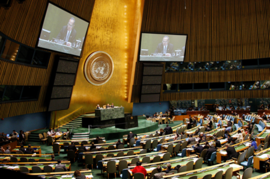 There is a growing recognition in the international community that making progress towards deep reductions in nuclear weapons stockpiles and their final elimination will pose significant verification challenges, and that new disarmament verification approaches and technologies urgently need to be developed to meet these challenges. At the 2010 nuclear Non-Proliferation Treaty (NPT) Review Conference, the 193 state parties agreed an "Action Plan on Nuclear Disarmament" that recognized "nuclear disarmament and achieving the peace and security of a world without nuclear weapons will require openness and cooperation, and ... enhanced confidence through increased transparency and effective verification." Action 19 of the plan noted that "All States agree on the importance of supporting cooperation among Governments, the United Nations, other international and regional organizations and civil society aimed at increasing confidence, improving transparency and developing efficient verification capabilities related to nuclear disarmament." A proposal for establishing such cooperation is taken up Ola Dahlman in his paper "How Can Science Support a Process Towards a World Free of Nuclear Weapons?" (Free PDF)
There is a growing recognition in the international community that making progress towards deep reductions in nuclear weapons stockpiles and their final elimination will pose significant verification challenges, and that new disarmament verification approaches and technologies urgently need to be developed to meet these challenges. At the 2010 nuclear Non-Proliferation Treaty (NPT) Review Conference, the 193 state parties agreed an "Action Plan on Nuclear Disarmament" that recognized "nuclear disarmament and achieving the peace and security of a world without nuclear weapons will require openness and cooperation, and ... enhanced confidence through increased transparency and effective verification." Action 19 of the plan noted that "All States agree on the importance of supporting cooperation among Governments, the United Nations, other international and regional organizations and civil society aimed at increasing confidence, improving transparency and developing efficient verification capabilities related to nuclear disarmament." A proposal for establishing such cooperation is taken up Ola Dahlman in his paper "How Can Science Support a Process Towards a World Free of Nuclear Weapons?" (Free PDF)
Dahlman proposes an International Scientific Network (ISN) to engage the global scientific community to explore how scientific and technological developments can support nuclear disarmament and non-proliferation. The ISN model draws on Dahlman's experience as chair of the Group of Scientific Experts supporting the negotiation of the Comprehensive Test-Ban Treaty (CTBT) from 1982-96 and then head of the working group on verification at the Preparatory Commission for the Comprehensive Nuclear-Test-Ban Treaty Organization until 2006. His article looks back at technical verification work on the CTBT and builds on it to sketch out some of the critical scientific and technological issues related to disarmament that might be the focus of an ISN.
One of the concerns that drove calls for nuclear disarmament during the Cold War and continues to be important is the risk of accidental nuclear war, which could have catastrophic and potentially civilization-ending consequences if it involved the arsenals of the major powers, especially those of the United States and Russia.
Anthony M. Barrett, Seth D. Baum and Kelly Hostetler take up this issue in "Analyzing and Reducing the Risks of Inadvertent Nuclear War Between the United States and Russia." They attempt to estimate the probability of inadvertent nuclear war between the U.S. and Russia under various conditions using a mathematical computer model that includes assumptions about the frequency of U.S.-Russian crises, failure rates and false warnings of early warning systems, and the effect of a terrorist nuclear attack during the crisis as a triggering event. The paper also considers the effect of policy options intended to reduce these risks.
The third paper in this issue deals with the recurring question of whether the abundance and cost of uranium is sufficient to support large-scale deployment of nuclear power. At the start of the nuclear age, it was believed that uranium was scarce and would become increasingly costly as nuclear energy programs expanded, inspiring efforts to develop civilian spent fuel reprocessing programs in anticipation of an eventual shift from uranium fueled reactors to using plutonium as a fuel. Such arguments are still used by reprocessing and plutonium breeder reactor advocates in Russia, India and China even though uranium costs have remained low and estimated resources have increased.
In "The Cost of Recovering Uranium from Seawater by a Braided Polymer Adsorbent System," Erich Schneider and Darshan Sachde present a detailed engineering cost estimate for uranium production from seawater (present at the level of a few parts per billion), a potentially vast reserve that could undercut further uranium resource scarcity arguments for using plutonium as a reactor fuel. They model a system proposed by researchers at the Japan Atomic Energy Agency that envisages recovery of 1200 tons per year of uranium from seawater using adsorbent-coated plastic fibers arranged in long buoyant braids chained to the ocean floor over an area of 1000 square-km. The braids are recovered after tens of days of immersion and returned to shore for uranium recovery, with the braids reused in the next campaign.
Schneider and Sachde find that for an initial adsorbent capacity of 2 kg of uranium per ton of adsorbent and 6 braid recycles, the uranium production cost is about $1200 per kg; the major cost drivers are adsorbent capacity (which is affected by seawater temperature), the number of recycles, and adsorbent degradation. For a roughly three-fold increase both in adsorbent capacity and the number of recycles, the uranium production cost drops to about $300 per kg. This is lower than typical estimates for the cost of uranium at which reprocessing and plutonium recycle in light-water reactors could become competitive with the once-through uranium fuel cycle.
